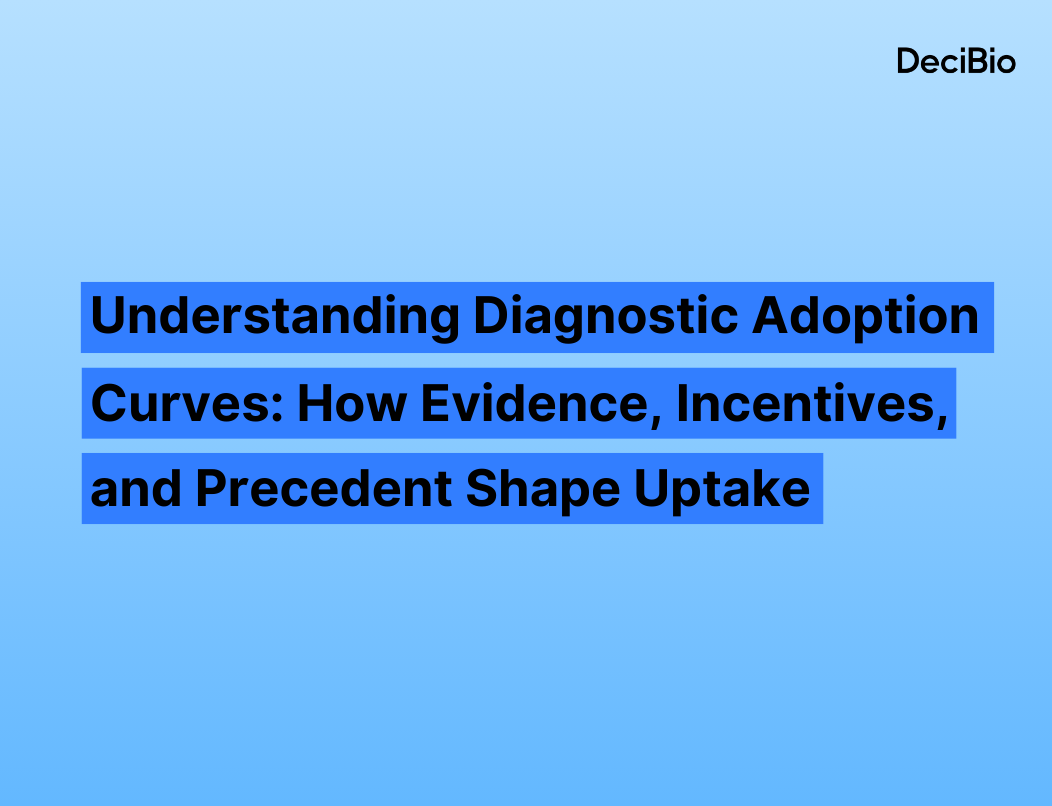New diagnostic tests typically follow a general adoption curve, but the pace and trajectory vary widely depending on clinical context, existing standards of care, and how novel the test is. Our analysis across five case studies (BRCA1/2, Oncotype DX, Cologuard, NIPT, and FIT) highlights shared milestones, archetypes, and adoption triggers that can inform go-to-market strategies for future technologies.
Novel use cases require more time for broad adoption
Breakthrough tests that introduce new paradigms in clinical practice, such as BRCA1/2 hereditary cancer testing, often face slower uptake due to a lack of clinical precedent, testing infrastructure, and clinician familiarity. In contrast, tests like Oncotype DX benefited from prior genetic testing precedent and a clear value proposition for payers, enabling faster adoption.
Adoption of new test modalities in existing applications depends on the market unmet need
Tests like NIPT replaced invasive procedures for a similar use case (e.g., amniocentesis) and saw rapid uptake due to strong patient demand and early coverage. However, Cologuard, while similarly addressing an existing use case with invasive testing (colonoscopy), took longer to gain traction due to its novel modality and higher cost, despite strong sensitivity. Colonoscopy is considered a gold standard (and also interventional, if needed) test with decent patient adherence rates and strong guideline recommendations, contributing to the slower adoption of Cologuard.
Key Adoption Milestones Across the Curve
- Innovators and Early Users are typically academic centers or reference labs willing to adopt based on early promise and clinical curiosity, often footing the bill. This can also include centers serving higher-income patients who are more likely to pay out of pocket for novel testing
- Early and Late Majority adoption hinges on broader clinical validation, inclusion in guidelines, payer reimbursement, and workflow integration
- Laggard uptake is often impacted by workflow complexity, cost, or lack of education, not just access and reimbursement. Incentives like bundled pricing, direct-to-consumer campaigns, or digital solutions can help enable access to the laggard segment
- Of note, even within these institutions, some stakeholders / physicians happen to be early or late adopters.
Validation Alone Isn’t Enough
While clinical studies are necessary, they rarely drive adoption in isolation. Across nearly all case studies, inflection points in uptake were driven by combinations of validation data, guideline inclusion (e.g., NCCN, ACOG, USPSTF), and payer action (e.g., Medicare, commercial coverage, or inclusion in HEDIS measures).
Structural Levers Catalyze the Shift to Scale
For example, BRCA testing remained niche until Myriad’s patents were overturned and prices dropped; Oncotype DX and NIPT saw surges after universal guideline updates; and FIT adoption expanded with ACA policy shifts, age-based screening expansion, and digital distribution tools.
Conclusion
Successful diagnostics don’t just deliver clinical utility; they reach it through a combination of precedent, policy alignment, and strategic timing. Understanding where a product sits on the curve and what barriers must be removed to unlock the next adopter group is essential to scaling impact.
This diagnostic adoption curve mini-series analyzes how select diagnostic technologies progressed from early innovation to widespread clinical use. Each case study highlights key adoption milestones, barriers, and inflection points.
Case Study #1: BRCA testing
We begin with BRCA testing, which followed a nontraditional adoption curve, constrained early by gene patents and high prices. For over a decade, uptake was limited to high-risk patients at AMCs. But after the 2013 Supreme Court ruling invalidated BRCA gene patents and public awareness surged, adoption expanded rapidly, driven by falling costs, broader guideline inclusion, and therapeutic implications. Additionally, PARP inhibitor approvals further advanced BRCA testing to include both germline and somatic mutations.
Case Study #2: Oncotype DX
Oncotype DX leveraged first-mover advantage to transform breast cancer treatment planning. As the first test to predict both recurrence risk and chemotherapy benefit, it filled a critical gap in clinical decision-making. Early adoption was steady but limited until payer coverage and guideline inclusion expanded access. The pivotal TAILORx trial validated its ability to help oncologists avoid overtreatment, triggering widespread uptake and reinforcing its role as a standard-of-care tool in precision oncology.
Case Study #3: Cologuard
Cologuard’s path to adoption was shaped by early setbacks and later strategic wins. Initial attempts at stool DNA testing failed to gain traction due to performance and regulatory concerns. The 2014 FDA approval, paired with simultaneous Medicare coverage, changed the trajectory by removing access barriers. Guideline inclusion and national quality measures like HEDIS supported payer adoption, while direct-to-consumer marketing helped build patient awareness. More recently, new competition from blood-based CRC screening tests is testing Cologuard’s staying power.
Case Study #4: NIPT
NIPT is one of the most rapidly adopted diagnostics in recent memory. After the discovery of cell-free fetal DNA in the late 1990s, early commercial launches in 2011 set off a wave of market saturation. What followed was intense competition, technological differentiation, and widespread payer alignment. Fast followers like Natera stood out through innovation and large-scale validation studies. The real turning point came when ACOG expanded guidelines in 2020 to recommend NIPT for all pregnancies, which significantly broadened access and helped NIPT become a global standard.
Case Study #5: FIT
FIT testing is a case of slow and steady adoption, ultimately driven by policy and infrastructure. Although developed in Japan in the 1980s, FIT entered the U.S. market in the early 2000s but faced stiff competition from colonoscopy. Over time, large validation studies and favorable guideline recommendations helped shift provider behavior. Inclusion in USPSTF guidelines and Medicare coverage under the ACA expanded access, while health system partnerships and simplified test formats improved uptake. FIT now stands as the most widely used CRC screening method in the U.S.
Across five diagnostic case studies, a clear pattern emerges: validation is essential, but it’s rarely enough. Whether it’s BRCA, Oncotype DX, NIPT, FIT, or Cologuard, major shifts in adoption typically required more than clinical data. Structural triggers like Supreme Court rulings, payer alignment, expanded guidelines, or workflow integration drove transitions from early adopters to mainstream use. Understanding these inflection points can help predict adoption trajectories for future diagnostics—and highlight what it takes to move from evidence to impact.
Note: DeciBio Consulting, its employees or owners, or our guests may hold assets discussed in this article/episode. This article/blog/episode does not provide investment advice, and is intended for informational and entertainment purposes only. You should do your own research and make your own independent decisions when considering any financial transactions.









